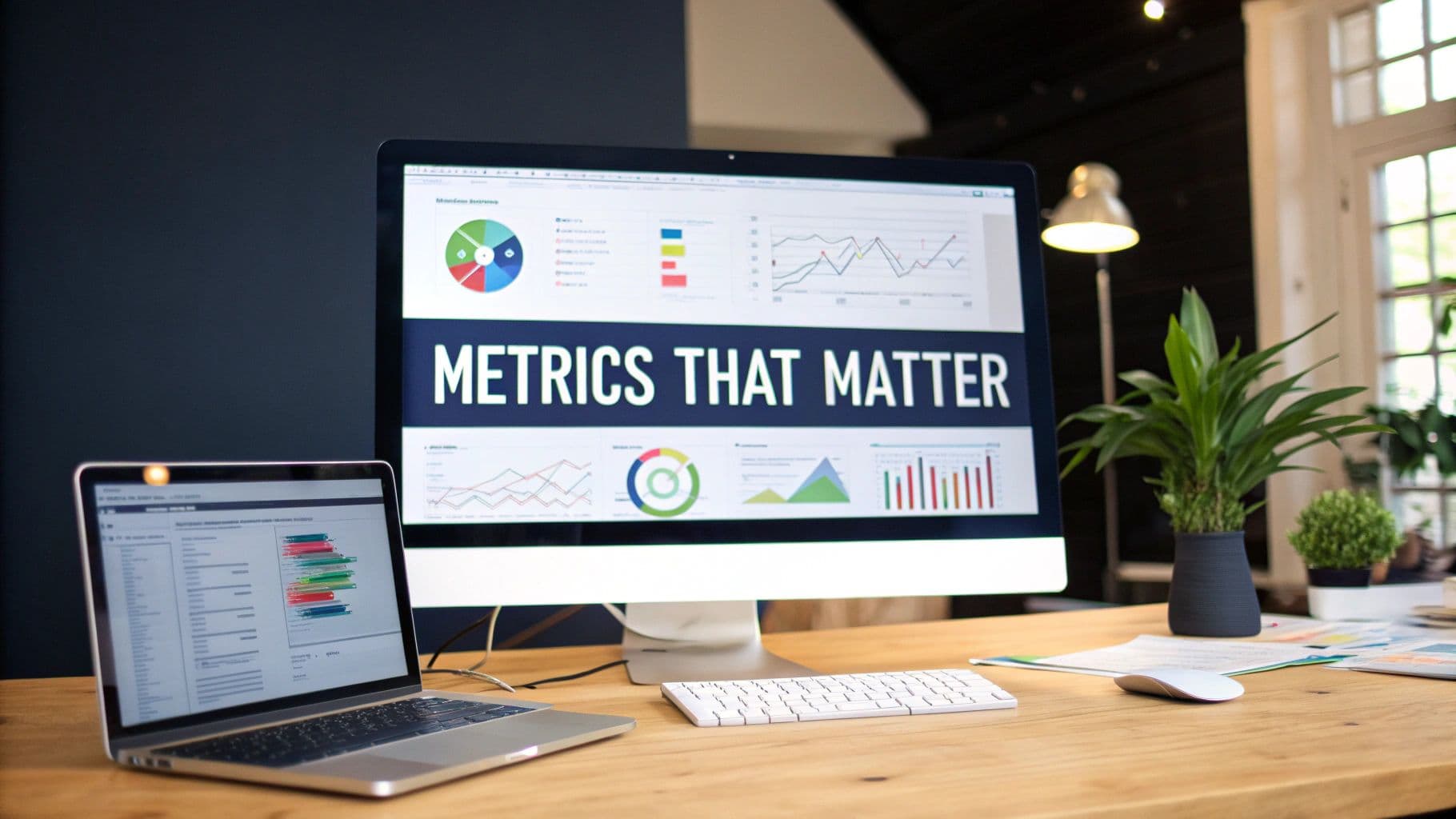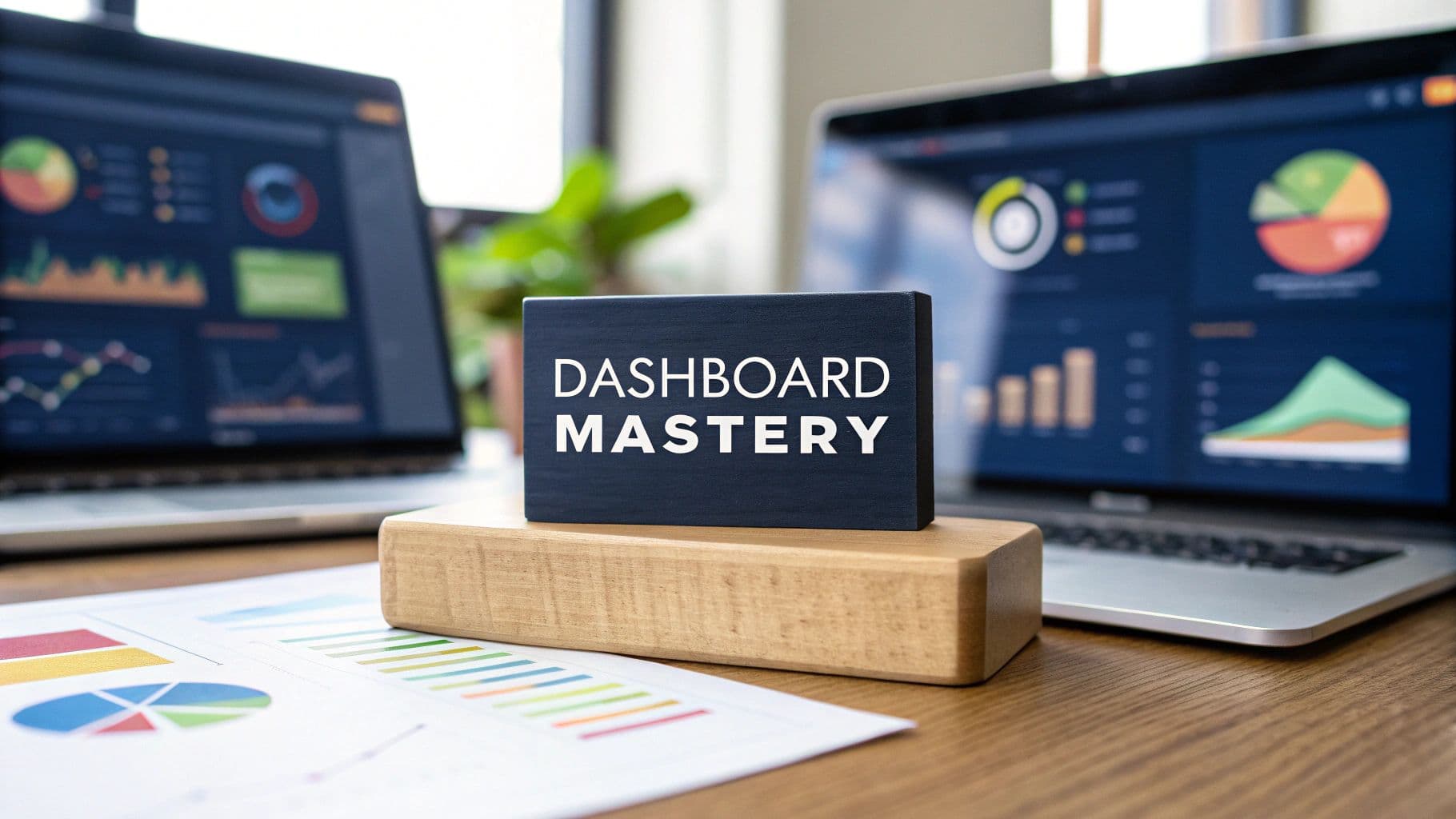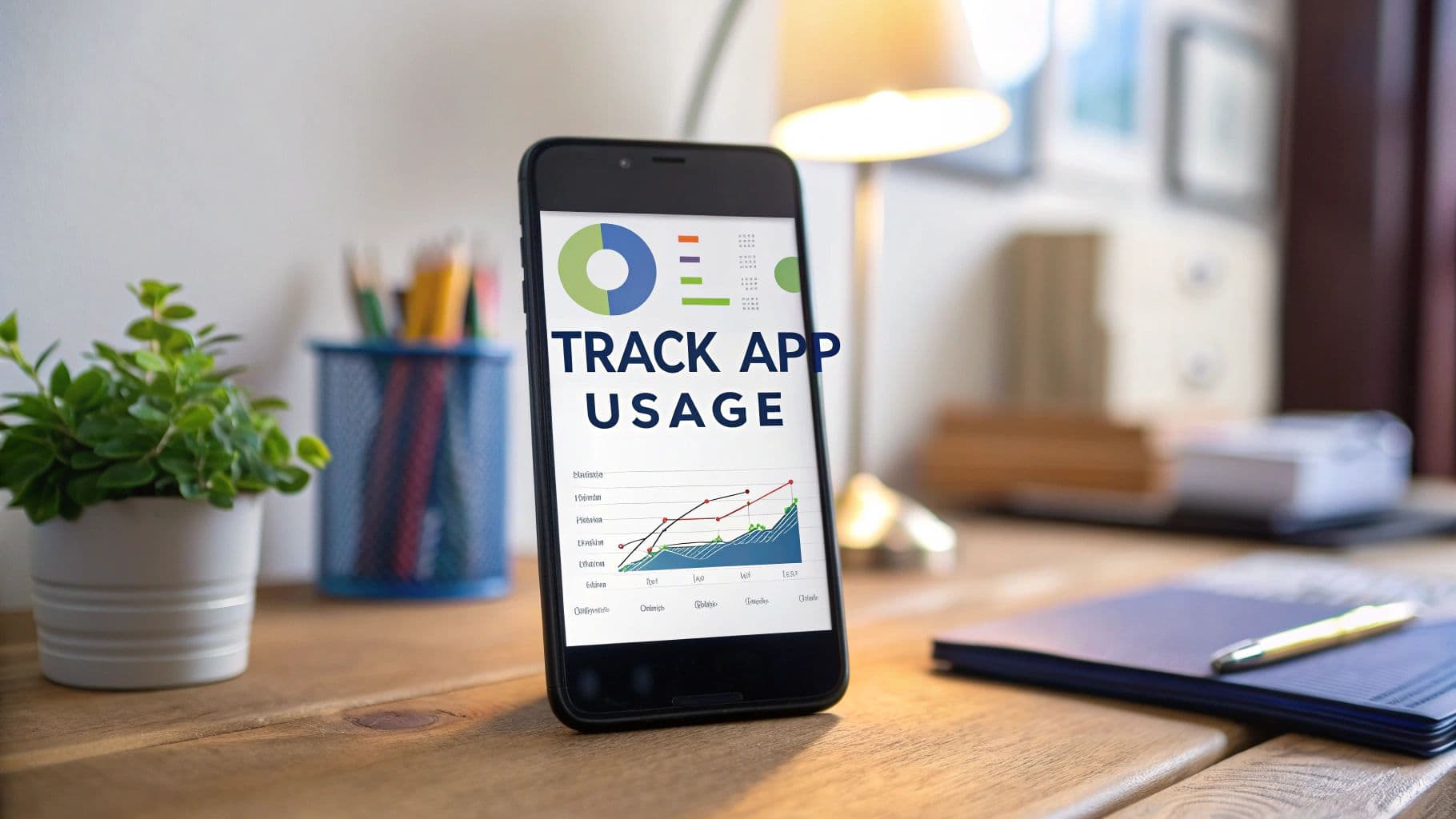A Guide to SaaS Artificial Intelligence
Discover how SaaS artificial intelligence is reshaping industries. This guide explains key benefits, real-world applications, and how to get started.
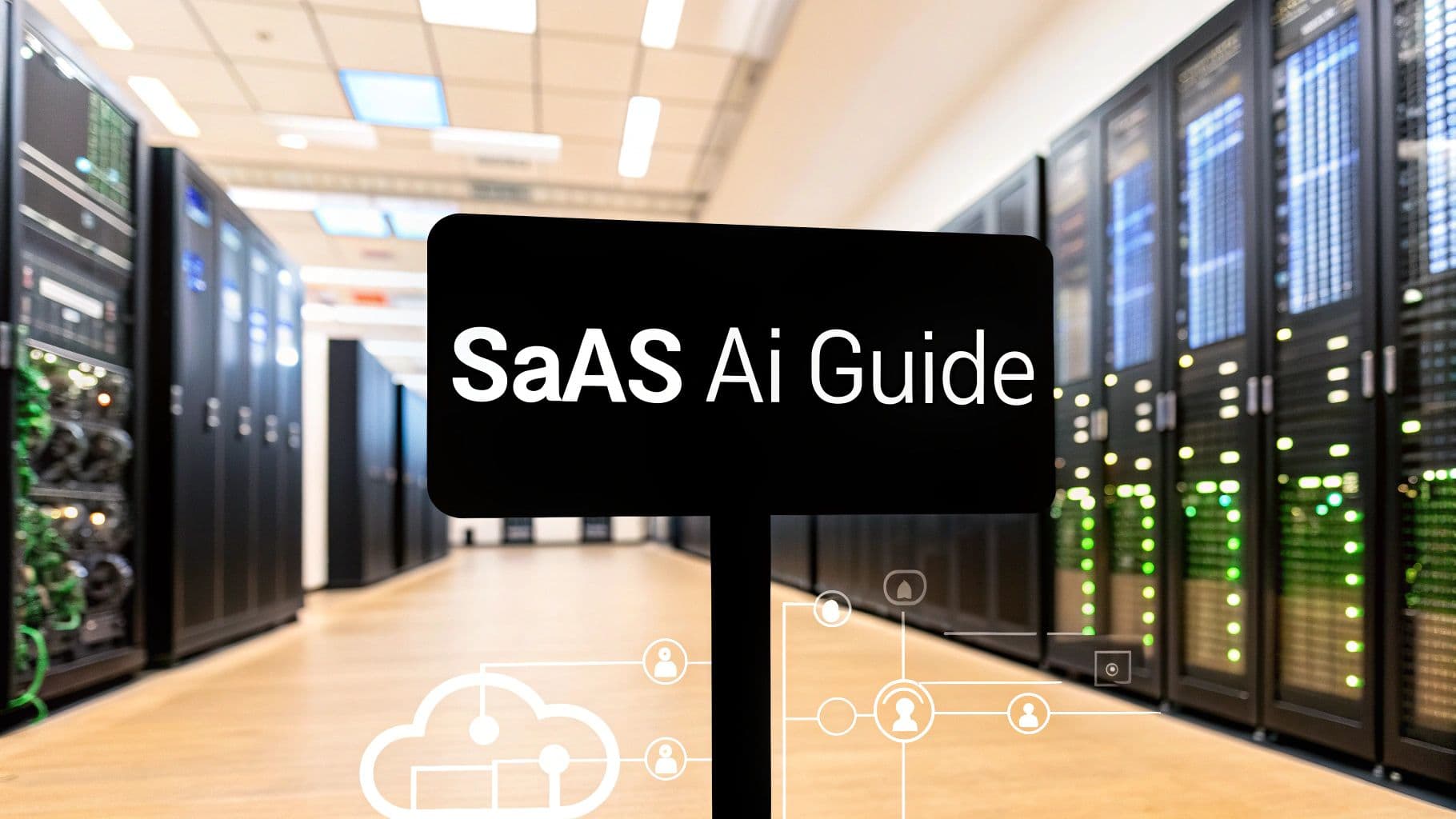
Think of your standard software like a dependable, by-the-book employee. It does exactly what you tell it to, every single time. Now, imagine that same employee could learn on the job, anticipate what a customer might need next, and even suggest better ways to get things done. That’s the jump from regular software to SaaS artificial intelligence. It's the powerful combination of easy-to-access cloud software and the genuine smarts of AI.
The Fusion of Cloud Software and Intelligent Machines
At its heart, SaaS AI is simply about delivering sophisticated AI tools—like machine learning and predictive analytics—through a straightforward, cloud-based subscription. It’s less like buying a massive, complex piece of machinery and more like hiring a team of experts on a monthly retainer. Instead of needing in-house data scientists and a server room full of expensive hardware, companies can tap into powerful intelligence right from the software they use every day.
This "as-a-service" approach has made AI a practical and affordable tool for almost everyone, not just the tech giants. It effectively removes the massive technical and financial roadblocks that once put artificial intelligence on a shelf too high for many businesses to reach.
Not only does this model make AI more accessible, but it also keeps the technology up to date without you lifting a finger. The vendors take care of all the messy backend work—updating algorithms, managing servers, and ensuring security—so you can stay focused on what the technology actually does for your business.
The Core Components of SaaS AI
So, how does it all come together? It helps to look at the main ingredients. The image below breaks down the foundational pillars that make SaaS artificial intelligence work.
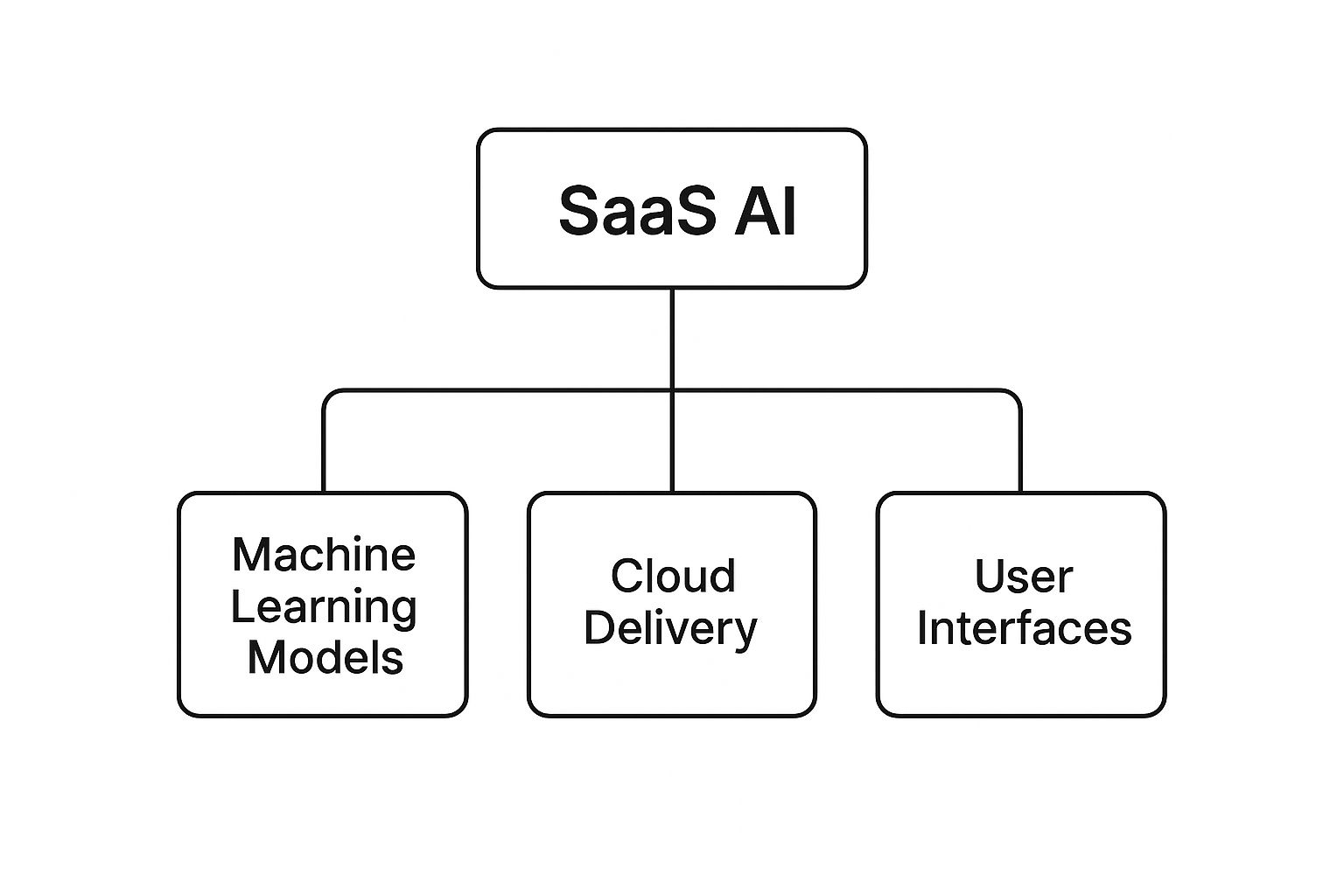
This structure really clarifies things. The machine learning models are the "brains," the cloud provides the "access," and the user interface gives you the "control." All three elements work together to create a seamless experience.
This shift isn't a small one; it's driving massive market growth. The global artificial intelligence market is on track to hit an incredible $1.81 trillion by 2030. That number alone tells you how critical this technology is becoming across every industry. Much of this explosion is thanks to the scalability and efficiency the SaaS model brings to AI. You can dig deeper into these AI SaaS market statistics to see the full picture of its industry-wide impact.
So, what does this powerful combination actually let you do?
- Make Sharper Decisions: Use predictive analytics to get ahead of market trends and spot opportunities buried deep in your data.
- Automate Intricate Work: Hand off repetitive or complex tasks to an intelligent system. This frees up your team to focus on creative, strategic initiatives.
- Create Personalised Customer Experiences: Let AI figure out user behavior so you can deliver tailored interactions that build real loyalty and keep people engaged.
How AI Is Reshaping the SaaS Model
Think of a traditional SaaS tool like a well-organized library. It's reliable, and you can always find the exact book you're looking for. It does exactly what you tell it to, efficiently and consistently. But it only ever responds to your direct commands.
Now, imagine that library has a new kind of librarian. This one gets to know you, notices what books are popular, and suggests titles you didn't even know you'd love. It doesn't just wait for you to ask for something; it anticipates what you'll need next. That's exactly what happens when SaaS and artificial intelligence come together. The software stops being a passive tool and becomes a dynamic, predictive partner.
At the heart of this shift is machine learning (ML), the engine driving modern AI. ML algorithms are built to sift through massive amounts of data—every user click, support ticket, and market trend—and learn from it. The more data they process, the sharper their insights and predictions become.
From Reactive Tools to Proactive Partners
Most traditional software is reactive by nature. You enter data, it stores it. You request a report, it creates one. The value you get is directly tied to the actions you take.
AI-powered SaaS completely flips this script. Instead of just holding onto your data, it actively analyzes it to spot hidden patterns and predict what might happen next. This turns a simple tool for data entry into a strategic advisor, guiding your decisions before you even know which questions to ask.
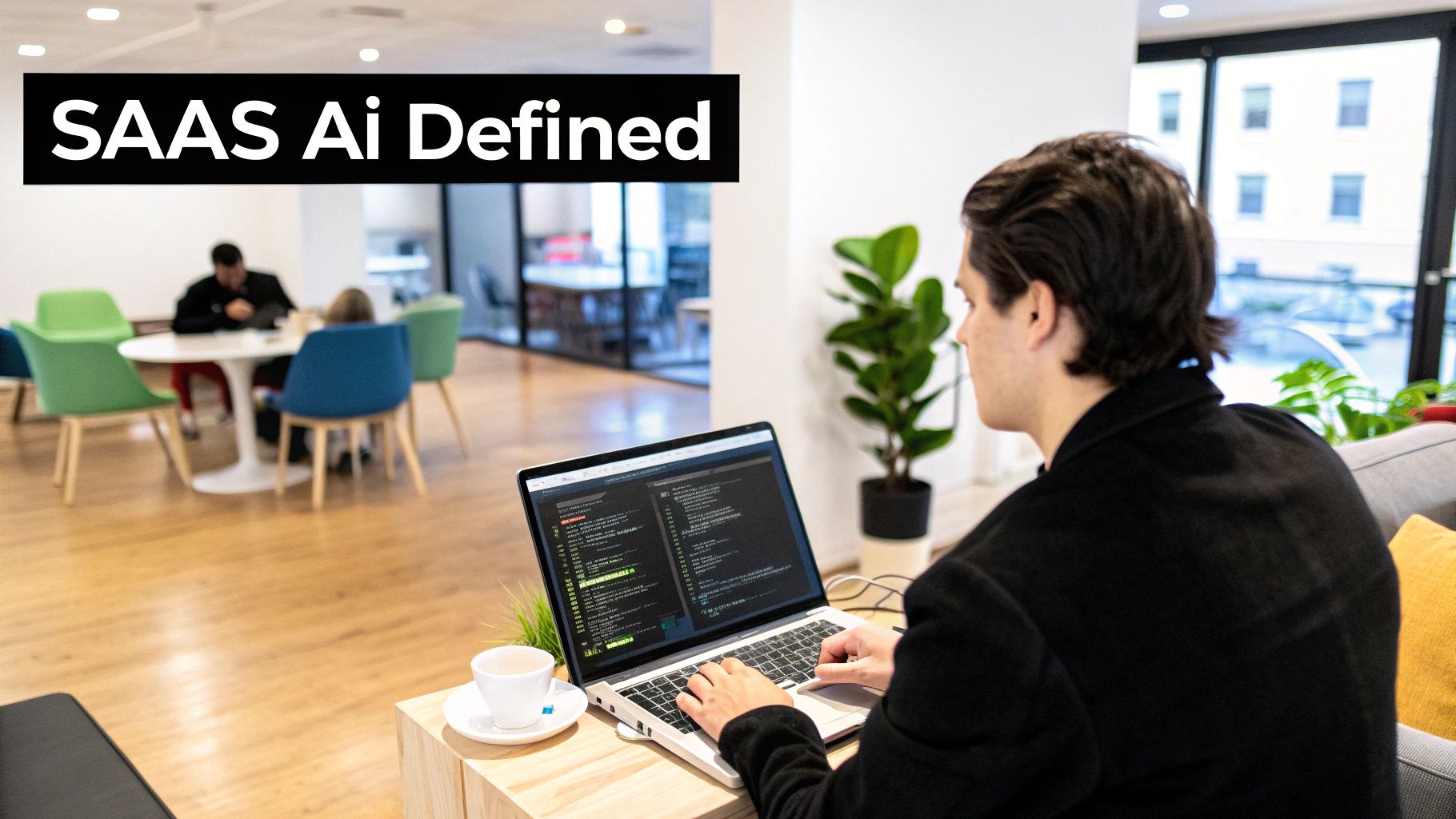
This proactive ability is creating huge waves in the market. The AI-created SaaS market is expected to explode from **101.73 billion in 2025 to over **1 trillion by 2032. A huge piece of that growth comes from machine learning, which is forecast to account for over 41% of the market. You can dig deeper into these AI-driven SaaS market projections to see where the industry is heading.
Unlocking Brand-New Capabilities
This change isn't just a concept; it unlocks tangible, powerful capabilities that redefine what software can do for a business.
- Predictive Analytics: An AI-powered CRM can look at past sales data and predict which deals are most likely to close this quarter. This helps sales teams focus their energy where it counts most, moving from simple record-keeping to actual revenue forecasting.
- Deep Personalization: Instead of one-size-fits-all campaigns, a marketing automation platform can analyze how individual users behave on your site and deliver truly unique content or product recommendations. It makes a one-to-one connection possible at a massive scale.
- Intelligent Automation: Forget basic, rule-based workflows. AI can manage complex, dynamic processes. It could, for example, analyze incoming support tickets, figure out the urgency and sentiment, and automatically send them to the right person—all without a human lifting a finger.
At the end of the day, adding AI to SaaS isn't about making old software a little faster. It’s about creating an entirely new category of software that learns, adapts, and works with its users. The value proposition shifts from just providing a service to delivering continuous, smart insights that fuel real business growth. Your software no longer just serves you; it works alongside you.
The Real-World Payoff of AI in SaaS

The magic of SaaS artificial intelligence isn't just about fancy algorithms or complex code; it’s about the tangible results it brings to a business. It’s the bridge between raw data and a stronger bottom line. These benefits typically cluster around three core areas that directly boost your efficiency, sharpen your strategy, and deepen customer relationships.
When you weave intelligence into your software, it stops being a passive database and becomes an active partner in your operations. Let's break down how this technology delivers real growth through automation, analytics, and personalization.
Drive Unmatched Efficiency with Intelligent Automation
Think about all the manual, repetitive chores your team gets bogged down with every day. We’re talking about things like sorting support tickets, transcribing meeting notes, or manually updating CRM records. These tasks are essential, but they drain time and energy that could be channeled into more strategic, creative work. Intelligent automation takes these tasks off your team's plate.
But this isn't your average, run-of-the-mill automation. While older systems follow rigid "if-then" rules, AI-powered automation understands context. It can read a frustrated customer email, detect the urgency in the language, and instantly route it to a senior support agent—all without a human clicking a single button. This frees your people up to solve the real problems.
It's no surprise that 76% of SaaS companies are already baking AI into their products, primarily to unlock these kinds of efficiencies. This isn’t a fleeting trend; it’s a fundamental shift in how modern businesses get things done.
Make Smarter Decisions with Predictive Analytics
Data is everywhere, but insight is rare. Most traditional SaaS platforms are great at showing you a rearview mirror of your business—what happened last quarter or last week. AI-powered tools, on the other hand, give you a look through the windshield, showing you what’s likely to happen next. That’s the power of predictive analytics.
Think of it like having a seasoned expert on your team who can spot subtle patterns in thousands of data points that no human ever could. It can analyze user behavior to flag customers who are showing early signs of churn, giving your success team a chance to step in and save the account before they decide to leave.
This shifts your entire strategy from reactive to proactive. Instead of putting out fires, you’re preventing them from starting. A few examples in the wild include:
- Sales Forecasting: An AI-infused CRM like Salesforce Einstein can look at your current pipeline, historical win rates, and the specifics of each deal to give you a startlingly accurate revenue projection.
- Inventory Management: For e-commerce, AI can predict a surge in demand for a certain product based on social media trends or seasonal patterns, helping you avoid costly stockouts.
- Lead Scoring: Instead of treating every lead the same, tools can analyze a lead's behavior and demographic data to tell your sales team exactly who to call first.
Build Stronger Relationships Through Deep Personalization
Let's be honest: in today's crowded market, a generic, one-size-fits-all experience just doesn't cut it anymore. Customers expect you to know them. AI-driven personalization is what makes it possible to deliver that unique, tailored experience to every single user, at scale.
SaaS AI works in the background, analyzing how each individual uses your product. It learns their preferences, understands their goals, and figures out what they need before they even ask. It then uses that insight to customize everything—from the marketing messages they receive to the features they see first when they log in. It makes the user feel like the software was designed specifically for them.
For example, a marketing platform powered by AI moves way beyond just adding a [First Name] tag to an email. It can figure out the perfect time to send that email, choose the blog post they’d find most interesting, and even tweak the subject line’s tone based on how they’ve engaged in the past. This level of thoughtfulness is what turns a casual user into a die-hard fan of your brand.
SaaS Artificial Intelligence in Action
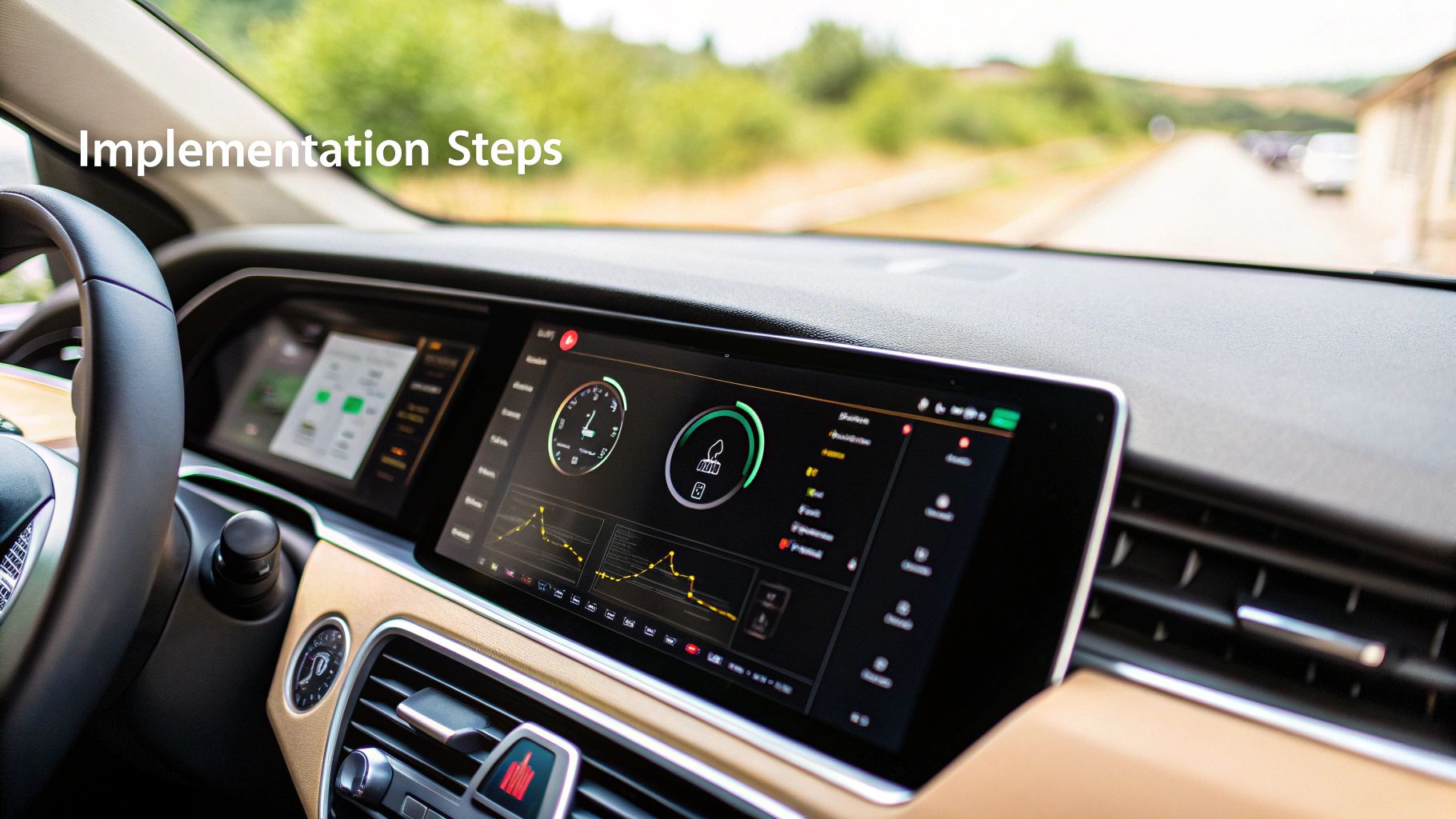
It’s one thing to talk about AI in theory, but seeing it work in the real world is where the lightbulb really goes on. To connect the dots between concept and reality, let’s look at how leading SaaS companies are putting artificial intelligence to work to solve real business problems and get a serious leg up on the competition.
These examples aren't just for massive corporations; they offer a playbook of ideas that can be adapted for businesses of any size. By seeing how AI is applied across different departments—from marketing and sales to customer support—a clear pattern emerges. Data-driven intelligence turns everyday operations into a genuine strategic advantage.
Optimizing Marketing with Predictive Insights
Modern marketing is a quest to send the right message to the right person at just the right moment. AI makes this possible on a scale that was once pure fantasy. Marketing automation platforms now lean on SaaS artificial intelligence to go way beyond generic email blasts, crafting personalized customer journeys that actually feel personal.
HubSpot is a perfect example of this. Its platform uses AI to dig into customer data and user behavior, fine-tuning every aspect of a marketing campaign. Instead of guessing when to send an email, HubSpot’s AI can pinpoint the optimal send time for each person based on their unique engagement history.
This intelligent approach also filters down to managing leads.
- Predictive Lead Scoring: HubSpot’s AI scores leads not just on who they are, but on how likely they are to actually buy. It analyzes website visits, email opens, and past data to flag prospects who are ready for a sales call, letting teams focus their energy where it counts.
- Content Strategy: AI tools can even analyze blog performance and industry trends to suggest new topics that will click with your audience, taking the guesswork out of your content calendar.
Closing More Deals with AI-Powered Sales
In sales, timing and focus are everything. Sales teams are constantly drowning in a crowded pipeline, struggling to figure out which deals deserve their attention. This is where SaaS artificial intelligence steps in and becomes a game-changer, transforming a standard CRM into an invaluable sales coach.
Salesforce Einstein is a classic example of AI woven directly into the sales process. It crunches historical deal data, customer interactions, and engagement signals to offer predictive insights, steering reps toward the most promising opportunities.
The screenshot above shows the Salesforce Einstein 1 Platform, which brings all these AI-driven analytics into one place. This isn't just a fancy dashboard; it shows how AI translates raw data into actionable intelligence, like deal health scores and revenue forecasts, helping teams make smarter decisions on where to spend their time.
One of its most powerful features is Opportunity Scoring.
- For every single deal, Einstein assigns a score from 1 to 99 that represents the probability it will close successfully.
- This score isn’t arbitrary. It’s calculated by analyzing dozens of factors, from the deal's size and stage to win rates on similar deals in the past.
- With a quick glance, a sales rep can see which deals need their immediate attention and which can wait, drastically improving their efficiency and close rates.
Enhancing Customer Support with Intelligent Automation
Great customer support needs to be fast, accurate, and available around the clock. But trying to scale a human team to meet that demand is incredibly expensive and complex. AI-powered chatbots and support platforms have stepped in to fill this gap, handling routine questions and freeing up human agents for the tough stuff.
Zendesk uses AI to automate and sharpen the entire customer service workflow. Its Answer Bot can instantly resolve common questions by understanding what a customer is really asking for and pulling the right answer from the knowledge base. This has a direct and positive impact on the business.
- Reduced Agent Workload: By deflecting all the simple, repetitive questions, AI chatbots let human agents focus on high-stakes problems that require real empathy and critical thinking.
- Improved Customer Satisfaction: Customers get instant answers, 24/7, without sitting in a queue waiting for help.
- Proactive Support: AI can even analyze customer behavior to spot potential issues before they blow up, allowing support teams to reach out and solve a problem before it starts.
From fine-tuning marketing campaigns to predicting sales and automating support, SaaS artificial intelligence is actively reshaping how business gets done. It proves that its value isn’t in some far-off promise, but in the practical, measurable results it delivers today.
Navigating the Challenges of AI Adoption
While the promise of SaaS artificial intelligence is exciting, getting it right means being realistic about the hurdles. Simply jumping in without a plan can lead to a lot of frustration, wasted money, and missed opportunities. But if you know what to look for, you can turn these common roadblocks into a clear path forward.
Everything starts with data—the lifeblood of any AI. This is often where companies first get into trouble. If your data is a mess—scattered across departments, inconsistent, or just plain inaccurate—your AI will be, too. An AI model is only as smart as the information it learns from, so feeding it bad data will only get you bad results.
Then there’s the issue of trust. When you use a SaaS AI tool, you're handing sensitive company data over to a third party. This means you absolutely have to do your homework on data privacy and security. You need to be confident in the vendor's security practices and have a crystal-clear understanding of how they handle, store, and protect your information.
Taming Technical and Financial Hurdles
Even if your data is pristine, getting a new AI tool to play nicely with your existing software can be a headache. You need to make sure it integrates smoothly with the systems you already rely on, like your CRM or ERP. Without that seamless connection, you end up with clunky, disjointed workflows that nobody wants to use.
Cost is another major factor to keep an eye on. The pay-as-you-go nature of SaaS is great, but it can also let spending spiral out of control if you're not careful. On average, companies juggle around 275 SaaS applications, but a shocking 53% of those licenses are never even used. That adds up to millions in wasted cash. As you add AI tools to that list, it becomes even more important to track usage and make sure you're actually getting your money's worth. You can dive deeper into the numbers in this report on SaaS spending and security.
Addressing the Human Element of AI
Finally, we can't ignore the human side of the equation. Algorithmic bias is a serious risk. If your training data reflects historical prejudices, the AI will pick them up and amplify them, leading to unfair decisions in everything from hiring to marketing. Tackling this means being intentional about using diverse, representative data and constantly checking the AI's outputs for fairness.
To navigate these challenges, you need a solid game plan. Here are a few practical steps to get you started:
- Prioritize Data Hygiene: Before you even think about shopping for vendors, get your data in order. Clean it up and consolidate it. A single source of truth is the bedrock of any good AI project.
- Vet Vendors Thoroughly: Don't be shy about asking the tough questions. Look for providers with strong security certifications like SOC 2 or ISO 27001 and dig into their data privacy policies.
- Start with a Pilot Program: Pick one specific, high-value problem you want to solve. Run a small test with a clear success metric to prove the SaaS artificial intelligence tool's worth before going all-in.
- Focus on Change Management: It's not enough to teach your team which buttons to click. You have to train them to trust and interpret the AI's insights. Help them understand the "why" behind the new tool to get them excited about its potential.
The Future of AI in SaaS
Looking over the horizon, the line between AI and SaaS is set to completely disappear. We're moving past the point where AI is just a nifty feature bolted onto your software. The next wave of innovation will make AI feel less like a tool you use and more like a strategic partner sitting at the table with you. We're talking about AI that's more sophisticated, more autonomous, and, crucially, more transparent.
The most obvious sign of this shift is the explosion of Generative AI. Sure, right now we think of it as something that writes blog posts or creates images. But its real future in SaaS is much bigger. Picture a platform that doesn't just crunch your quarterly sales numbers; instead, it hands you a complete strategic report. This report would include deep market analysis, a rundown of what competitors are doing, and a clear set of recommended next steps. That's where we're headed.
It's a move from tactical assistant to strategic creator. Instead of helping you draft a marketing email, the SaaS AI of tomorrow will design the entire campaign from scratch—from figuring out the perfect audience segment to creating the visuals and even forecasting how well it will perform.
The Dawn of Hyperautomation
From there, the next logical leap is into hyperautomation. Think of this as AI becoming the central nervous system for your entire company. It won't be stuck inside a single app. Instead, it will connect and manage complex workflows across all the different SaaS tools you use.
Imagine this: your product analytics tool flags a customer who's at risk of churning. The AI instantly creates a task in your team's project management software, alerts the product team, and simultaneously kicks off a personalized retention campaign through your marketing platform. No human needed to connect the dots.
This kind of seamless, cross-platform intelligence gets rid of the manual handoffs and bottlenecks that slow businesses down. It's the ultimate promise of SaaS AI: an autonomous operational backbone that can manage critical business processes from start to finish.
A Growing Demand for Transparency
As we hand over more mission-critical tasks to AI, one thing will become non-negotiable: transparency. The days of the "black box" algorithm, where you have no idea how the AI reached its conclusion, are numbered. This is where Explainable AI (XAI) steps in.
The future of enterprise AI adoption hinges on trust. XAI will be a non-negotiable feature, allowing businesses to understand why an AI made a specific recommendation, ensuring accountability, fairness, and compliance.
Companies will need to see the logic behind an AI's sales forecast or its decision to flag a transaction, especially in highly regulated fields like finance or healthcare. This push for transparency is what will build the confidence needed for businesses to truly weave AI into their core operations. The future of AI in SaaS isn't just about raw power; it's about building a genuine, trustworthy partnership between people and their intelligent systems.
Got Questions? We've Got Answers
Stepping into the world of SaaS artificial intelligence can feel like learning a new language. Let's clear up a few of the most common questions so you can navigate it with confidence.
On-Premise AI vs. SaaS AI: What's the Real Difference?
So, what's the deal with on-premise AI versus SaaS AI? The easiest way to think about it is buying a car versus using a ride-sharing app.
On-premise AI is like buying the car. You're responsible for everything—the upfront cost, the garage (your servers), the gas, the oil changes, and all the repairs. It requires a hefty initial investment and a skilled team just to keep it on the road.
SaaS AI, on the other hand, is the ride-sharing service. You just pay a subscription fee and get access to powerful AI whenever you need it, all through the internet. The provider takes care of the complex engine work and maintenance behind the scenes, making it a much more accessible and budget-friendly choice for most businesses.
How Can a Small Business Get Started with SaaS AI?
If you're a small business, the idea of implementing AI can seem daunting. The trick is to avoid boiling the ocean. Start small and focus on solving a single, nagging problem.
- Find Your Biggest Pain Point: Where does your team get stuck? Is it the endless stream of customer support tickets? Maybe it's trying to figure out which sales leads are actually going to close. Pinpoint one area where you're bleeding time or money.
- Look for Tools in That Specific Area: You'll find that many modern SaaS tools already have AI features baked right in. Hunt for a platform designed to solve the exact problem you just identified.
- Take It for a Test Drive: Never commit without trying it first. Almost every reputable tool offers a free trial. Use it to see if the software actually makes a difference for your team. It's the best way to prove the value without any risk.
Is My Data Actually Secure with a SaaS AI Provider?
Handing your data over to a third party can feel like a leap of faith. The truth is, top-tier vendors treat security as their number one job, but it's on you to do your homework.
When you're looking at a new SaaS AI tool, don't just take their word for it on security. Certifications aren't just fancy logos; they're proof that a company has undergone serious, independent audits of its security and privacy measures.
Always check for compliance with major security standards. Look for certifications like SOC 2, GDPR, and ISO 27001. You should also read up on their data encryption practices and privacy policies. These aren't just formalities—they're a clear sign of how seriously a provider takes protecting your information.
Ready to turn customer feedback into your biggest growth driver? SigOS uses AI to analyze support tickets, sales calls, and usage data, showing you exactly which features will reduce churn and which will unlock major revenue. Stop guessing and start building what your customers truly need. Discover your product's hidden revenue signals with SigOS.
Keep Reading
More insights from our blog
